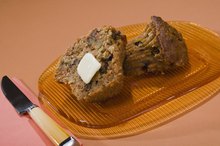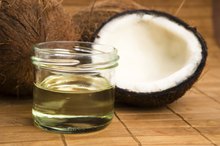What does fact checked mean?
At Healthfully, we strive to deliver objective content that is accurate and up-to-date. Our team periodically reviews articles in order to ensure content quality. The sources cited below consist of evidence from peer-reviewed journals, prominent medical organizations, academic associations, and government data.
- American Heart Association: Know Your Fats
- National institute of Diabetes and Digestive and Kidney Disorders: What I Need To Know About Eating and Diabetes
The information contained on this site is for informational purposes only, and should not be used as a substitute for the advice of a professional health care provider. Please check with the appropriate physician regarding health questions and concerns. Although we strive to deliver accurate and up-to-date information, no guarantee to that effect is made.
What Are Visible Fats?
All fats in your diet are classified either as visible or invisible fat. Fats that you use for cooking or add to your foods are visible fats, while those that contribute to the taste and flavor of a food, but you cannot see, are invisible fats. Both visible and invisible fats are naturally present in many foods. Regardless of the form, all fats are concentrated sources of energy that provide 9 calories in every gram of fat you eat. By limiting your intake of visible fat, you can reduce the total number of calories consumed.
Sources of Visible Fat
Visible fats are obviously familiar and come from a variety of sources. All kinds of cooking and salad oils, including olive, canola and sunflower oils, are also visible fats that are liquid at room temperature. Apart from these sources of visible fat that you can buy from the aisles of your grocery, some visible fats are present on the cuts of meat, bacon and poultry skin.
Sources of Invisible fat
Fat in Indian Foods
Learn More
When visible fats are used to cook foods, they become an integral part of the food and are then called invisible fats. These include the fats present in many favorite snacks and deserts such as:
- potato chips
- cookies
- cakes
- doughnuts
- pastries
- ice creams
- chocolate
Eggs, milk, coconuts and most nuts also contain invisible fat.
Saturated Fats
The fatty acids that make up visible and invisible fats are responsible for the characteristic of the fat and the impact the fat has on your health. Saturated fatty acids are predominantly present in visible fats from animal sources such as butter, meat and milk fat, although coconut, palm and palm kernel oils are also rich in saturated fatty acids. Saturated fats increase your risk for heart diseases by raising the levels of low-density lipoprotein cholesterol 1. You should limit your intake of visible fats that contain saturated fats to lower your risk of heart disease 1.
Mono- and Polyunsaturated Fats
The Disadvantages of High Saturated Fat Levels
Learn More
Canola, olive and peanut oils contain mono-unsaturated fatty acids, which decrease your risk of heart disease as they lower the levels of low-density lipoprotein cholesterol in blood 2. Polyunsaturated fatty acids that are present in oils such as canola, corn, safflower and sunflower also help to improve blood cholesterol levels and reduce risk of heart disease 2. The essential omega-3 fatty acids are polyunsaturated fatty acids that are present in fatty fish and soybean oil. Limiting your intake of visible fats, however, can help reduce your risk of obesity, heart disease and even cancer 1.
Related Articles
References
- American Heart Association: Know Your Fats
- Utah State University: Fat and Cholesterol
- "Dietary Guidelines for Americans," United States Department of Health and Human Services. January, 2010. https://health.gov/dietaryguidelines/2010/.
- Gropper SS, Smith JL, Groff JL. "Advanced Nutrition and Human Metabolism." Fourth Edition. Belmont, CA. Wadsworth Pub Co. 2005.
Writer Bio
As a scientist and educator, Sukhsatej Batra has been writing instructional material, scientific papers and technical documents since 2001. She has a diverse scientific background, having worked in the fields of nutrition, molecular biology and biochemistry. Batra holds a PhD in foods and nutrition, and a certificate in professional technical communication.









